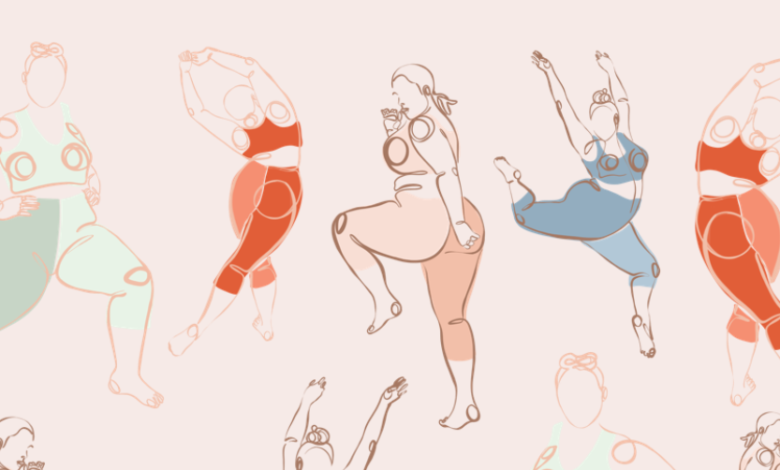Can a Person Be Fat and Fit? Health Experts Say Yes

Throughout 2021, Good Housekeeping will be exploring how we think about weight, the way we eat, and how we try to control or change our bodies in our quest to be happier and healthier. While GH also publishes weight loss content and endeavors to do so in a responsible, science-backed way, we think it’s important to present a broad perspective that allows for a fuller understanding of the complex thinking about health and body weight. Our goal here is not to tell you how to think, eat, or live — nor is to to pass judgment on how you choose to nourish your body — but rather to start a conversation about diet culture, its impact, and how we might challenge the messages we are given about what makes us attractive, successful and healthy.
You probably don’t need a bunch of research scientists to tell you that the average American woman wears a size 16-18 — just looking around, the real-life bodies we see at the gym or on line at the ATM are usually bigger than the images in ads. And folks who look like the vast majority of people in this country are starting to gain more visibility, as body positive influencers like model Olakemi, yogi Jessamyn Stanley, insecurity-normalizer Mik Zazon, dance workout instructor Jessica Diaz-Herrera and men’s fashion blogger Kavah King, to name a few — pop up on social media. More people, proud of their thick thighs, big booties and “fluffy” abs are unrolling their yoga mats, swinging their kettlebells and joining the cultural conversation about body ideals and feeling healthy.
But while bigger bodies are having a moment (and fingers crossed it’s more than just a moment) implicit bias against higher weight people is actually on the rise, as a new study out of Boston University Medical School found that the average size of a Victoria’s Secret model has actually gone down since 1995, creating an even bigger disparity between most women and this particular version of the ideal.
Also raining on this still-burgeoning parade of people accepting their bodies as they are is the chorus of concerned citizens claiming to be worried about the health of larger folks. They assume — thanks to how our culture has erroneously conflated a lower body weight with overall health and fitness — that plus-size women can’t possibly be physiologically healthy, looking as they do. Just recently, Cosmopolitan UK, our sister magazine across the pond, placed women of various sizes on their cover with a headline, “This is Healthy!” and got all manner of blowback, including accusations of “promoting obesity,” as if that’s a thing.
In fairness, when we’ve all been told for generations that thin is healthy and fat is unhealthy, even by our doctors, it’s understandable that people think this way. But this “worry” about another person’s health is often more about fatphobia than actual concern. So what’s the deal? Can you actually be healthy at a higher weight? Can you be fat and fit? The short answer is yes! Here’s what you need to know:
This content is imported from {embed-name}. You may be able to find the same content in another format, or you may be able to find more information, at their web site.
What does it mean to be “fat and fit?”
“When you hear the phrase ‘fat and fit,’ that’s the idea that your BMI is elevated for your height, despite having a healthy lifestyle that includes eating well and exercising regularly,” says Navya Mysore, M.D., a primary care doctor at One Medical in New York City. Traditionally, medical experts have considered the BMI (body mass index) to be the key (or even sole!) indicator of a healthy weight, as well as a barometer to help determine your risk for certain chronic conditions like diabetes and heart disease. According to that line of thinking, it doesn’t matter whether you are Serena Williams-level athletic and have the healthiest of habits — if the ratio of your weight to your height doesn’t fall in the “normal” range, you weigh too much. Plain and simple.
But a growing number of healthcare professionals are now saying that bodyweight is actually not the best way to assess health. “And the idea is valid — you can be considered a few pounds ‘overweight,’ but if you’re getting regular physical activity and eating a nutritious diet, I’m not worried, because those lifestyle habits are great,” says Dr. Mysore. It’s the health-supporting behaviors you practice on a daily basis, as well as crucial health indicators like blood pressure, cholesterol, blood sugar and hormone levels, that may matter more than your BMI or the number on the scale.
How you feel also helps explain what it means to be “fat and fit.” “It’s important to break down those walls of conventional body image and societal norms,” says Theodore “Teddy” Savage, head of health and fitness at Planet Fitness. For example, no matter how you look, if you have energy, wake up feeling refreshed, and can do everyday tasks like climbing the stairs or getting up from a chair without getting out of breath, you’re very likely fit.
And the opposite can be true, too. People assume a lack of body fat means health, but that’s not necessarily the case. The term “skinny-fat” refers to the idea that “You can look super ‘in-shape,’ but if you don’t have the best behaviors when it comes to exercise and what you put inside your body, you may not be as physically healthy inside,” Savage adds. A ‘normal’ BMI does not preclude you from being metabolically “obese” with risk factors like high cholesterol and elevated blood sugar, and an “obese” BMI does not automatically denote poor health. Interestingly, one study shows that weight discrimination — rather than body weight itself — is “associated with risk for arteriosclerosis, diabetes, high cholesterol, myocardial infarction, minor heart conditions.”
Understand that body size isn’t within most people’s control.
Even if bodyweight alone was a good indicator of your fitness level, there are people who simply won’t have a small body no matter what they do. Genetics, ethnic background, and family history all have a big impact on body type, as well as where you hold your fat and how your metabolism functions, says Dr. Mysore. “If mom and dad have a certain body type or cardiovascular risk factors like high blood pressure, those can be inherited and influence your own body type or risk for potential future health issues,” she adds.
We also know that nutrition can play a role in body weight, but many people who are interested in eating in ways that dietitians suggest could lead to a lower weight cannot afford to, or may not have the time ability to prepare or buy fresh, healthy meals all the time, Savage points out.
Additionally, your exposure to physical activity and the types of sports you had access to growing up also have an impact on your adult fitness level. “There are specific types of training associated with different types of sports or activity, and that ultimately affects your body type,” says Savage. “It dictates how your muscles grow, whether or not you’re prone to lean muscle or bulkier ones, and whether what you need to eat to sustain that activity simply makes you likelier to carry a few extra pounds.”
So, what’s a better way to measure health?
Experts agree that you can live in a larger body and still be fit and healthy, but that does not mean weight plays zero role in the complex story of certain conditions. “Obesity is tied to chronic conditions like diabetes, heart disease and some cancers,” says says Sharon D. Allison-Ottey, M.D., member of the African American Wellness Project. Your weight is not necessarily causing those illnesses—indeed, it might be a symptom. But carrying around a lot of excess weight gain may contribute, says Dr. Mysore. The problem arises when body weight becomes the central focus, with weight loss as the main cure, when there are other issues at play.
Where you carry your weight may matter, too, says Dr. Mysore — some studies show that carrying much of your fat around your middle may be more dangerous than when it’s situated in your hips, butt or legs because it wraps around important internal organs, which can do damage and trigger the development of chronic diseases over time. Things like blood pressure, glucose levels, and cholesterol can also give you good clues as to how healthy you really are inside, says Dr. Allison-Ottey, regardless of the number on the scale.
But creating a routine of healthy lifestyle habits that you consistently maintain can play a huge role in helping you mitigate those health indicators, no matter your weight. “Invest in a health and wellness routine that you’re consistent with. Exercise in particular promotes lower blood pressure and cholesterol levels, as well as decreases your risk for type 2 diabetes — all key heart disease risk factors,” says Savage. “Along with a well-balanced diet, proper hydration, and restful sleep, you can create the total picture of physical and mental wellness.”
How to be fit and healthy at any weight
No matter what your body looks like, these are the lifestyle habits that will help support good overall health.
- Move your body: Everyone should strive to get 150 minutes of moderate or 75 minutes of vigorous physical activity a week, says Dr. Allison-Ottey. “Moderate means you should break a sweat and feel your heart rate go up, but still be able to talk,” she says. “Vigorous means you’re breathing hard and fast and probably can’t carry on a conversation.”
- Incorporate strength training: “This is an important aspect of a well-balanced exercise regimen. It improves muscle and bone strength, but also supports good heart health and cognitive function,” says Savage. If you’re just starting out, he recommends starting with two to three days of weight work a week, with a day in between each where you only do cardio and stretching. Once you progress, you’ll be better able to determine how often is ideal for you.
- Eat nutritiously: The people with the best health outcomes eat a diet that consists of lots of fiber-filled fruits and veggies; protein like meat, fish, or pulses (beans, lentils, and other legumes); whole grains; healthy fats like nuts, avocado, and olive oil; and no more than 50 grams of sugar per day. And don’t forget to incorporate one more component: Pleasure! “Food is a necessity, but it’s also a source of enjoyment, so I don’t believe that restrictive dieting is the answer, and scientists are conducting research that seems to support that notion, too,” says Elizabeth Shaw, M.S., R.D.N., owner of ShawSimpleSwaps.com. Eating intuitively, according to what looks good and what you think will make you feel good, has helped many people find their way to a diet that’s healthy for them, rather than worrying too much about external rules. So tune into internal body cues (are you truly hungry, satisfied or stuffed-to-the-brim full?) to help determine your eating patterns, she adds.
- Tame stress: Research shows that stress, no matter the source, can harm your body, says Dr. Mysore. Chronic stress also contributes to development of chronic conditions like high blood pressure, diabetes, and heart disease over time.
This content is created and maintained by a third party, and imported onto this page to help users provide their email addresses. You may be able to find more information about this and similar content at piano.io





